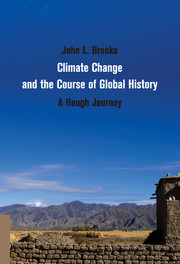Book contents
- Frontmatter
- Dedication
- Contents
- List of Figures and Tables
- Acknowledgments
- List of Abbreviations
- Introduction
- Part I Evolution and Earth Systems
- Part II Domestication, Agriculture, and the Rise of the State
- Part III Ancient and Medieval Agrarian Societies
- 6 Stasis and Growth in the Epoch of Agrarian Empires
- 7 Optimum and Crisis in Early Civilizations, 3000–500 BC
- 8 A Global Antiquity, 500 BC–AD 542
- 9 The Global Dark and Middle Ages, AD 542–1350
- Part IV Into the Modern Condition
- Data Bibliography: Full Citations for Data Used in Figures and Tables
- Index
- References
8 - A Global Antiquity, 500 BC–AD 542
Published online by Cambridge University Press: 05 August 2014
- Frontmatter
- Dedication
- Contents
- List of Figures and Tables
- Acknowledgments
- List of Abbreviations
- Introduction
- Part I Evolution and Earth Systems
- Part II Domestication, Agriculture, and the Rise of the State
- Part III Ancient and Medieval Agrarian Societies
- 6 Stasis and Growth in the Epoch of Agrarian Empires
- 7 Optimum and Crisis in Early Civilizations, 3000–500 BC
- 8 A Global Antiquity, 500 BC–AD 542
- 9 The Global Dark and Middle Ages, AD 542–1350
- Part IV Into the Modern Condition
- Data Bibliography: Full Citations for Data Used in Figures and Tables
- Index
- References
Summary
The Problem of Growth in Antiquity
Throughout global prehistory during the last four millennia BC, the trajectory and pulse of climate change provided one of the fundamental variables in the human condition, establishing the boundaries within which life was conducted. Under these conditions, it is safe to say, population growth rarely came near to overwhelming local resources. In general, however, populations did grow, particularly in the Old World centers running from the eastern Mediterranean to China. Here obviously the slow, incremental advance of techno-agrarian adjustment of the inheritance of the Late Neolithic “secondary products revolution” played a fundamental role, as slight improvements in material culture allowed populations to expand slowly but inexorably, the trajectory of their increase regularly set back by natural disasters of various scales. The net result seems to fit the economist’s model of the Malthusian stalemate: by this account, as populations rose or as climates shifted slightly, people either moved or gradually adopted new crops and new techniques in Boserupian intensifications that may have temporarily improved conditions until the slow rise in numbers or another refraction in climate washed out the improved effect.
Such is the classic account. But the world historians see another dynamic at work, an incremental, cyclical ratcheting of culture and technology, best expressed in Jack Goldstone’s framework of efflorescences, or Eric Jones’s “growth recurring.” These pulses in the human condition can be dated from earliest agricultural origins, but start more markedly with the Late Neolithic intensification of agrarian practice and mastery of ceramics. Out of the kiln and glazing would evolve the knowledge of metals that has underwritten all subsequent economies, and at the time shaped the accumulation of political power that would be structured by and perpetuate the material memory systems of writing and monumental art.
- Type
- Chapter
- Information
- Climate Change and the Course of Global HistoryA Rough Journey, pp. 317 - 349Publisher: Cambridge University PressPrint publication year: 2014



